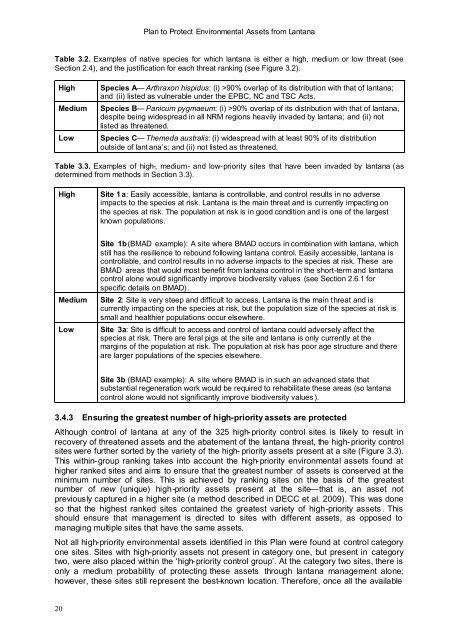Plan to Protect Environmental Assets from Lantana - Weeds Australia
Plan to Protect Environmental Assets from Lantana - Weeds Australia
Plan to Protect Environmental Assets from Lantana - Weeds Australia
You also want an ePaper? Increase the reach of your titles
YUMPU automatically turns print PDFs into web optimized ePapers that Google loves.
<strong>Plan</strong> <strong>to</strong> <strong>Protect</strong> <strong>Environmental</strong> <strong>Assets</strong> <strong>from</strong> <strong>Lantana</strong><br />
Table 3.2. Examples of native species for which lantana is either a high, medium or low threat (see<br />
Section 2.4), and the justification for each threat ranking (see Figure 3.2).<br />
High<br />
Medium<br />
Low<br />
Species A— Arthraxon hispidus: (i) >90% overlap of its distribution with that of lantana;<br />
and (ii) listed as vulnerable under the EPBC, NC and TSC Acts.<br />
Species B— Panicum pygmaeum: (i) >90% overlap of its distribution with that of lantana,<br />
despite being widespread in all NRM regions heavily invaded by lantana; and (ii) not<br />
listed as threatened.<br />
Species C— Themeda australis: (i) widespread with at least 90% of its distribution<br />
outside of lant ana’s; and (ii) not listed as threatened.<br />
Table 3.3. Examples of high-, medium- and low-priority sites that have been invaded by lantana (as<br />
determined <strong>from</strong> methods in Section 3.3).<br />
High<br />
Site 1a: Easily accessible, lantana is controllable, and control results in no adverse<br />
impacts <strong>to</strong> the species at risk. <strong>Lantana</strong> is the main threat and is currently impacting on<br />
the species at risk. The population at risk is in good condition and is one of the largest<br />
known populations.<br />
Medium<br />
Low<br />
Site 1b(BMAD example): A site where BMAD occurs in combination with lantana, which<br />
still has the resilience <strong>to</strong> rebound following lantana control. Easily accessible, lantana is<br />
controllable, and control results in no adverse impacts <strong>to</strong> the species at risk. These are<br />
BMAD areas that would most benefit <strong>from</strong> lantana control in the short-term and lantana<br />
control alone would significantly improve biodiversity values (see Section 2.6.1 for<br />
specific details on BMAD).<br />
Site 2: Site is very steep and difficult <strong>to</strong> access. <strong>Lantana</strong> is the main threat and is<br />
currently impacting on the species at risk, but the population size of the species at risk is<br />
small and healthier populations occur elsewhere.<br />
Site 3a: Site is difficult <strong>to</strong> access and control of lantana could adversely affect the<br />
species at risk. There are feral pigs at the site and lantana is only currently at the<br />
margins of the population at risk. The population at risk has poor age structure and there<br />
are larger populations of the species elsewhere.<br />
Site 3b (BMAD example): A site where BMAD is in such an advanced state that<br />
substantial regeneration work would be required <strong>to</strong> rehabilitate these areas (so lantana<br />
control alone would not significantly improve biodiversity values ).<br />
3.4.3 Ensuring the greatest number of high-priority assets are protected<br />
Although control of lantana at any of the 325 high-priority control sites is likely <strong>to</strong> result in<br />
recovery of threatened assets and the abatement of the lantana threat, the high-priority control<br />
sites were further sorted by the variety of the high- priority assets present at a site (Figure 3.3).<br />
This within-group ranking takes in<strong>to</strong> account the high-priority environmental assets found at<br />
higher ranked sites and aims <strong>to</strong> ensure that the greatest number of assets is conserved at the<br />
minimum number of sites. This is achieved by ranking sites on the basis of the greatest<br />
number of new (unique) high-priority assets present at the site—that is, an asset not<br />
previously captured in a higher site (a method described in DECC et al. 2009). This was done<br />
so that the highest ranked sites contained the greatest variety of high-priority assets . This<br />
should ensure that management is directed <strong>to</strong> sites with different assets, as opposed <strong>to</strong><br />
managing multiple sites that have the same assets.<br />
Not all high-priority environmental assets identified in this <strong>Plan</strong> were found at control category<br />
one sites. Sites with high-priority assets not present in category one, but present in category<br />
two, were also placed within the ‘high-priority control group’. At the category two sites, there is<br />
only a medium probability of protecting these assets through lantana management alone;<br />
however, these sites still represent the best-known location. Therefore, once all the available<br />
20

















